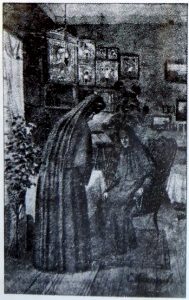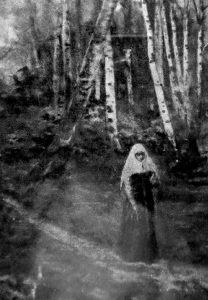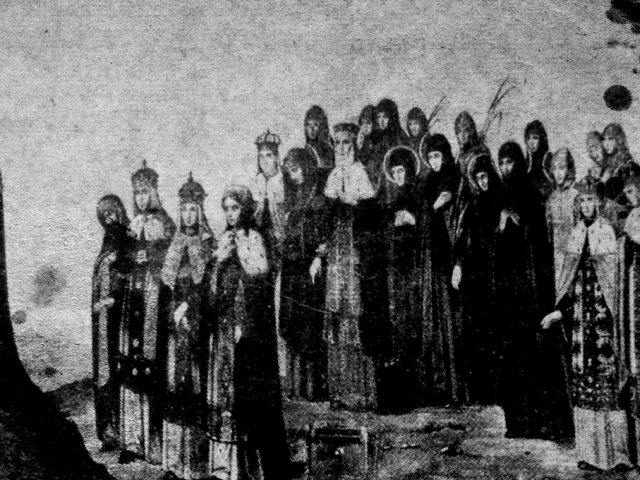“Let women keep silence in the churches.” 1 Cor. 14:34
Away from the tumult and noise of this world, in quiet monastic refuges, in deserted landscapes which evoke thoughts of eternity, women of Holy Russia worked out their salvation for a thousand years, striving to acquire first of all humility of wisdom.
The spiritual fragrance of this key virtue in Patristic Orthodoxy, that of humility of wisdom, which is the joining together of humility and wisdom, has always been very close to true Orthodox women, and especially to the women Saints. Behind them there always shines forth the humble image of Her Who is the first Abbess of all monastics, the Most Holy Theotokos.
 Particularly is this true of the women Saints of Holy Russia, who were penetrated by this quiet, refined, and pure virtue that only very meager information has even come down to us about them. They strove to be unseen, unnoticed, concealed in quiet monastic cells behind monastery walls, located beyond distant lakes and rivers, in forgotten sketes and hidden green thickets, in the shadow of weeping willows and birch groves, which alone heard their quiet prayer and soft chanting and saw them beholding the bridal chamber of their Divine Bridegroom, Christ.
Particularly is this true of the women Saints of Holy Russia, who were penetrated by this quiet, refined, and pure virtue that only very meager information has even come down to us about them. They strove to be unseen, unnoticed, concealed in quiet monastic cells behind monastery walls, located beyond distant lakes and rivers, in forgotten sketes and hidden green thickets, in the shadow of weeping willows and birch groves, which alone heard their quiet prayer and soft chanting and saw them beholding the bridal chamber of their Divine Bridegroom, Christ.
The number of women Saints known by the church on earth falls far short of the number of men Saints, and there has come down to us a surprisingly small number of their lives, many of which are brief and rather general. This does not, however, mean that their numbers were really so few or that they did not attain the spiritual heights of men—but only emphasizes the surpassing beauty of their other-worldly humility and silence (hesychia).
The Orthodox women Saints, unlike Martha, sit at the feet of the Lord and pay heed to the words of Christ: Mary hath chosen the best part, which shall not be taken away from her (Luke 10:42)—and they keep silence in the churches (1 Cor. 14:34).
The very beginning of Christianity in Russia occurred through a holy woman, St Olga, Equal to the Apostles (+969, July 11), whose grandson, St. Vladimir (+1015, July 15) baptized his Kievan princedom in 988 and gave the whole of Russia the Orthodox Christian Faith at the very time when Byzantium had reached its highest point in all phases of spiritual culture. By this time all the basic heresies had been identified and uprooted by the Seven Ecumenical Councils, and monasticism was in full bloom. Thus, Russia from the very beginning was entrusted with the fullness of the pure faith, Orthodoxy, and she treasured it throughout the ages as the supreme heritage in her hierarchy of values, herself thereby becoming, in the activities and hopes of her best sons and daughters, Holy Russia, the guardian of Orthodoxy. Such she has remained until this very day, even while in bonds and in the catacombs under the Communist Yoke.
Monasticism immediately captured the Russian soul and was practiced in Kievan Russia in monasteries and convents built by princes and noblemen. It flourished predominately in the Kiev Caves, which began with a spark brought to Russia from Mount Athos by St. Anthony. Monasteries both for men and women began to spring up in various places, being founded chiefly by princes, who saw them as a treasuries of sanctity for their principality, but also by hierarchs, by monks, and by righteous women—some even being founded by women for men, as in case of St Euphrosyne of Polotsk, that great pilgrim-lover of Byzantium and the Holy Land, where she reposed in the Lavra of her beloved St Theodosius the Coenobiarch, her relics being later translated to the Kiev Caves.
The coming of the Tatar barbarians, who demolished Kiev, burning and destroying on their way all the monasteries and killing their inhabitants, did not cut off the growth of monastic communities. On the contrary, the number of communities increased. The astonishing impulse for the foundation of new monasteries, which now moved northward, was as it were an answer to the question of how to retain the Orthodox philosophy of life. In addition to providing a harmonious and economically independent communal life, these monasteries, which formed an Orthodox mentality in the full spirit of the Church, opened in a mystical realm of spiritual perfection which transfigured earthly men, women, and children into Angel-like beings. This inspired the newly-enlightened Russian people, and a whole network of monastic citadels sprang up around Novgorod, Pskov, Suzdal and, of course Moscow, which, after the fall of the Second Rome, Constantinople, became the Third Rome. Great Saints founded monasteries in this period: St. Anna of Novgorod (1050, Oct 4); three Pskov Abbesses: Eupraxia (1243, May 8), Martha (1300, Nov 8), and Bassa (1473, March 19); St Charitina, Abbess of Novgorod (1281, Oct 5), foundress of two convents; and many others in Moscow, borth canonized and uncanonized.
Monastic communities of virgins in Holy Russia were greatly esteemed and honored. The women’s monasteries were always thought of as holy places, havens for ascetic labor, with a life centered about the cycle of beautiful and all-encompassing church services, for which refined liturgical arts were developed. The use of convents as hospitals, orphanages, schools, and workshops was always secondary, when it appeared at all. The ancient Byzantine models of asceticism, which were constantly present through the reading of the Synaxaria, the Prologue, and the lives of the Saints, were the main source of monastic inspiration and it was there that the heart of the women of Holy Russian lay.
It is wrong to say, simply because no striking Lives of such women Saints have come down to us, that women in ancient Russia did not follow the severe anchoretic, hesychast practices of the desert-dwellers of old. There is sufficient indication in the sources that remain that there were indeed such heroines, who waged no less fierce battles with the prince of this world than the great holy men whose lives are well known to us. The lives of women anchorites in later—such as Abess Eupraxia of Old Ladoga (1823, Sept 23) and Blessed Mary of Cave-digger of the White Mountains (1822, June 22)—show clearly what was in the hearts of women Saints in that earlier time when the whole Russian society marveled at the anchoretic fervor of the dwellers of the unknown northern wilds.
 The monastic movement of the holy women of Russia, to be sure, took forms that were somewhat different from those of the holy men of the North. It was the men who—in the steps of St Sergius of Radonezh—were fearless “pioneers” of the northern forests, braving the untrodden territories of Russia with their constant dangers from wild animals, roaming Tatars and robbers, and the sheer physical hardships of establishing a monastic settlement in an uninhabited forest. The great desert-dwellers, after founding a monastic community, would usually move northward and find a new solitary desert, followed by their disciples, and often their disciples themselves would leave the original monasteries to found their own communities. Women desert-lovers would then settle near the village which had grown up around the monastery, or in the monastery buildings themselves, if they had been deserted by the monks; thus they would have the protection of an established place already carved out of the wilderness and surrounded by a fence or wall. Here the women desert-dwellers would continue the founder’s rule and tradition. Often it would be little-known women ascetics who would hand down the only information we have about some Saint. Thus, when the relics of St Cyril of Velsk (15th c., June 9) were discovered incorrupt, it was a certain Righteous Nun Aquilina Nakapa (1517) who gave information about the unknown Saint, having herself received a miraculous healing from him, as had the Righteous Eulampia; and so the story of St Cyril was handed down to us—but nothing more is known of Blessed Aquilina and her monastic tradition.
The monastic movement of the holy women of Russia, to be sure, took forms that were somewhat different from those of the holy men of the North. It was the men who—in the steps of St Sergius of Radonezh—were fearless “pioneers” of the northern forests, braving the untrodden territories of Russia with their constant dangers from wild animals, roaming Tatars and robbers, and the sheer physical hardships of establishing a monastic settlement in an uninhabited forest. The great desert-dwellers, after founding a monastic community, would usually move northward and find a new solitary desert, followed by their disciples, and often their disciples themselves would leave the original monasteries to found their own communities. Women desert-lovers would then settle near the village which had grown up around the monastery, or in the monastery buildings themselves, if they had been deserted by the monks; thus they would have the protection of an established place already carved out of the wilderness and surrounded by a fence or wall. Here the women desert-dwellers would continue the founder’s rule and tradition. Often it would be little-known women ascetics who would hand down the only information we have about some Saint. Thus, when the relics of St Cyril of Velsk (15th c., June 9) were discovered incorrupt, it was a certain Righteous Nun Aquilina Nakapa (1517) who gave information about the unknown Saint, having herself received a miraculous healing from him, as had the Righteous Eulampia; and so the story of St Cyril was handed down to us—but nothing more is known of Blessed Aquilina and her monastic tradition.
Another kind of desert-loving holy woman is to be found in ancient Russia in a place which might easily be overlooked today when Orthodox society has become so worldly and the fundamentals of Orthodox upbringing have been largely forgotten. The primary duty which the Church lays upon women is not merely in the rearing of children, but, more importantly, the breathing into them of the sacred fragrance of humility and meekness of heart, which seals the spiritual bond between Christ and the child from infancy onward. This is no easy task, and never was. It is to this task that the spiritual energy of desert-loving women went in ancient Russia. Thus it is that many great Saints of the Northern Thebaid had great Saints for their mothers. The love for the life of paradise in the wilderness, and the spiritual strength that comes from a humble heart capable of enduring the hardships of the desert, were first given to the ascetics of the North during the guilelessness of childhood by their angel-like mothers, who, being unable to go to the northern desert themselves by reason of their worldly obligations, raised up sons fit to be desert-dwellers.
The mother of St Sergius of Radonezh was St Maria, nun of Khotkov (1337); of St Alexander of Svir, St Barbara, nun of Oyat (1500); of St Macarius of Kolyazin, St Irene of Kozhin (15th c., June 1); of St Phillip Metropolitan of Moscow and monk of Solovki, St Barsanuphia schema-nun of Moscow; the mothers of the fools for Christ of the North, Sts Nicholas Kochanov and John of Ustiug, were the Righteous Julianna (1384, Dec 21) and Abbess Natalia; and there were others. The sister of St Artemius of Verkola was the blessed Paraskeva of Pirimin, venerated locally as a Saint. The widely-venerated St Juliana of Murom (1604 Jan 2), who raised many children and grandchildren, was a desert-dweller at heart.
Originally printed in the Orthodox Word Vol. 11, No. 2, March-April 1975


